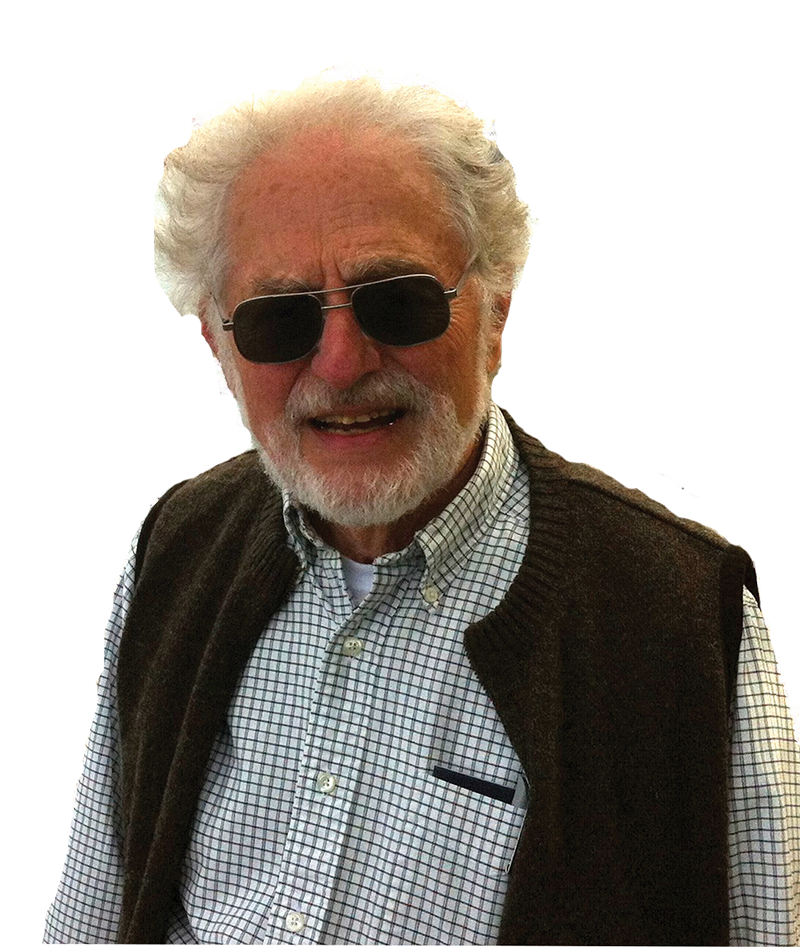
 Machinist Alex Vaynberg (left), Professor Eugene Commins (center), and his last graduate student, Chris Regan (right), pose by their atomic beam magnetic- resonance device, which they used to set a new limit on the electric dipole moment of the electron. Due to interference from the BART trains, they could only run the experiment at night, from 2 a.m. to 6 a.m. Credit: Eugene Commins
Machinist Alex Vaynberg (left), Professor Eugene Commins (center), and his last graduate student, Chris Regan (right), pose by their atomic beam magnetic- resonance device, which they used to set a new limit on the electric dipole moment of the electron. Due to interference from the BART trains, they could only run the experiment at night, from 2 a.m. to 6 a.m. Credit: Eugene Commins
TL: What is the experiment you’re most proud of?
EC: Oh, the last one we did. I don’t work in the lab anymore. I’m too old for that. I decided that I was too old during the last experiment I did, with a gifted student, Chris Regan. But I’m very proud of that project, putting a limit on the electric dipole moment, which we published in 2002. It was a good, hard experiment, and required a lot of ingenuity. The magnetic field from the BART trains was interfering with our measurements, so we had to work when they weren’t running, between two o'clock and six o'clock in the morning!
TL: You’ve seen huge changes in the field over your career. What are the biggest differences?
EC: I think that physics is the victim of its own success. Here’s what I mean: when I was born, Chadwick discovered the neutron using an apparatus that probably cost him less than $10. He did it all by himself, the paper he wrote was crystal-clear, and the results were as persuasive and clean as they can be. Even when I was at Columbia, most experiments were modest and human-scale. You could read physics journals and understand most of the papers, even those not in your field.
But nowadays, the problems we’re tackling have become complicated and ultra-specialized. All the easy questions have gotten solved, and people moved on to much more difficult questions. Now you see lists of authors longer than the papers themselves, and those experiments cost millions of dollars. I don’t really know if this is sustainable.
TL: You’ve been a musician and painter for most of your life. Do you think that your interest in art has affected your outlook as a scientist?
EC: I feel that music and science go hand in hand. I love music and I love physics. There is great aesthetic appeal in the equations of physics. Maybe that’s in the eye of the beholder, but I think that there’s great beauty in finding an elegant, symmetrical solution to a very difficult problem. For example, relativity is an enormously elegant solution to a subtle, complicated problem. Or quantum mechanics; it’s very mysterious, and therefore very beautiful.
 A painting by Professor Eugene Commins. Credit: Eugene Commins
A painting by Professor Eugene Commins. Credit: Eugene Commins
TL: Many of your students have mentioned your strengths as a graduate advisor. What was your mentoring philosophy, and how did you develop it?
EC: Like so many other things I’ve done, I haven’t really known what I was doing. I did everything by the seat of my pants. There’s no hard and fast rule when it comes to mentoring. You have to see what the student needs, have some intuition about what works, and most importantly, you need to pay attention to them. When it comes to my students, I’ve always been surprised by their brilliance and their ingenuity. They kept surpassing anything I expected of them, which is really a wonderful thing to see. Seeing a student become a scientist in their own right: that’s probably given me more satisfaction than anything else.
TL: What advice do you have for current students?
EC: Well, you have to take the long view, and you need to have self-confidence. But I think the most important thing is courage. When you try to do something interesting, it will certainly be hazardous. There’s a high likelihood it won’t work. You see, if you choose something that’s sure to work, it’s not going to be interesting. But if you choose a problem that’s really interesting, then chances are it’s not solved, and there’s always going to be danger in that. But it’s really worth it, in the end, isn’t it?
This article is part of the Fall 2013 issue.



